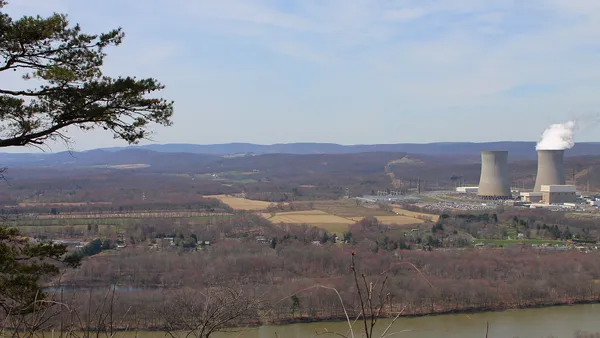Dive Brief:
- The shift away from coal-fired power generation will force the Intermountain Power Plant (IPP) in Utah to shutter in a few years, and Renewable Energy World reports that at least one provider who takes energy from the plant is considering a novel storage facility to take its place.
- Burbank Water & Power, which takes more than 3% of the plant's output, has been working with Schulte Associates LLC to consider a 1,200 MW compressed air storage facility to be located at IPP's site.
- The plan involves taking power from the planned 3,000 MW Pathfinder Renewable Wind Energy project in Wyoming, and bringing it to the storage facility over a proposed 500 kV transmission line, with energy stored when wind is plentiful and used when prices rise.
Dive Insight:
Current proposals to replace the Intermountain Power Agency's 1,800 MW plant have so far focused on a gas-fired facility, but Renewable Energy World reports another proposal has been floated that could help integrate more renewables and not generate carbon emissions.
Burbank Water & Power, which purchases about 3.4% of IPP's output, has engaged Schulte Associates LLC to consider a compressed air energy storage facility on the site, which would utilize wind energy to power the 1,200 MW proposal. But the idea would require a lot of moving parts to come together, as the 3,000 MW Pathfinder wind project, which would supply the storage facility, is still being developed, along with the transmission line that would move the power.
The proposal calls for wind power to be used to pump air into underground caverns, which could be released later – during expensive peak periods – to provide electricity.
While utility-scale storage projects are cropping up around the nation as a way to integrate more renewables and shift peak usage, so far most proposals call for more traditional battery storage options. But the compressed air project represents a new direction for clean energy tech development, with increasingly innovative proposals being considered.
At this point, however, the technology is not widely deployed, with only two large-scale compressed air storage facilities operating in the world. A major difficulty in its development is that such facilities are dependent on suitable geological formations to store the compressed air, but some developers are looking at more innovative approaches, such as utilizing old underground mines as storage facilities.
In an even more novel approach, Toronto Hydro last month announced it has constructed the world's first underwater energy storage, developing a compressed air system with Hydrostor about two miles off Toronto Island in Lake Ontario.
At its peak, the 660 kW system's output is capable of powering approximately 330 homes. Depending on how much power is drawn, the system can currently run for a little over an hour.















